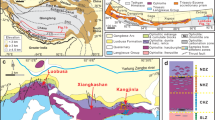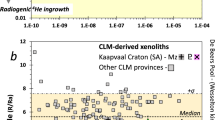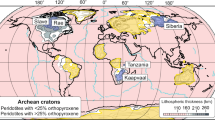Abstract
THE present high gradient of density in the upper mantle provides neutral buoyancy zones in which certain minerals may have been accumulated in the past or to which they may still be migrating. The necessary condition for progressive accumulation in such a zone is that the mineral concerned has opportunities of rising or sinking relative to its surroundings with a velocity which, averaged over long periods, is great enough to overcome the bulk convective drift if such occurs. Frank1 has pointed out the high heat transfer capability of a small volume fraction of melt fluid percolating through the bulk, compared with bulk convection. With percolation active, it is likely that a fluctuating distribution of migration and local concentration of fluid has been the dominating pattern of events in the mantle, at least down to 500 km, during a large fraction of the Earth's history. Hence it is unlikely that any portion of the mantle above this level has escaped epochs during which fluid has percolated through it. If during such an epoch of involvement in local fluidity the fluid fraction becomes sufficient to lower the effective viscosity to within an order of magnitude of that of a normal homogeneous melt, then insoluble crystals suspended in the partial melt, rising or falling under buoyancy forces, could well attain velocities a million-fold greater than any plausible bulk convection velocity of the mantle in which the localized partial melt is embedded.
This is a preview of subscription content, access via your institution
Access options
Subscribe to this journal
Receive 51 print issues and online access
$199.00 per year
only $3.90 per issue
Buy this article
- Purchase on SpringerLink
- Instant access to full article PDF
Prices may be subject to local taxes which are calculated during checkout
Similar content being viewed by others
References
Frank, F. C., Nature, 220, 350 (1968).
Berman, R., in Physical Properties of Diamonds (edit. by Berman, R.) (Clarendon Press, Oxford, 1965).
Bundy, F. P., J. Chem. Phys., 41, 3809 (1964).
Birch, F., J. Geophys. Res., 69, 4377 (1964).
Bullen, K. E., An Introduction to the Theory of Seismology, third ed. (Cambridge Univ. Press, 1963).
Tozer, D. C., in The Earth's Mantle (edit. by Gaskell, T. F.) (Academic Press, London and New York, 1967).
Frank, F. C., Proc. Intern. Industrial Diamond Conf., Oxford, 1966 (Industrial Diamond Information Bureau, London, 1967).
Frank, F. C., in The Application of Modern Physics to the Earth and Planetary Interiors (edit. by Runcorn, S. K.), 247 (Wiley-Interscience, London and New York, 1969).
Goldschmidt, V. M., Geochemistry (edit. by Muir, A.), 74 (Clarendon Press, Oxford, 1954).
Author information
Authors and Affiliations
Rights and permissions
About this article
Cite this article
LANG, A. Diamond Accumulation in the Upper Mantle. Nature 226, 345 (1970). https://doi.org/10.1038/226345a0
Received:
Issue date:
DOI: https://doi.org/10.1038/226345a0



